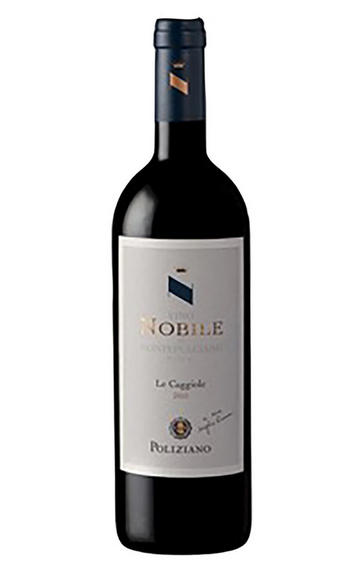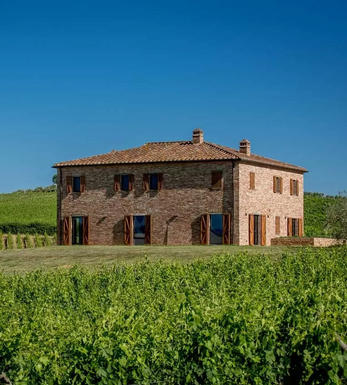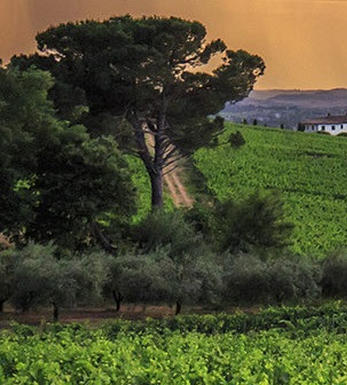
2019 Vino Nobile di Montepulciano, Le Caggiole, Poliziano, Tuscany, Italy

Critics reviews
Intensely spicy and complex, the 2019 Vino Nobile di Montepulciano Le Caggiole smoulders up from the glass with a bouquet of crushed ashen stones, dried black cherries, cedar spice box and rosemary. This is pure elegance, deep and textural, with a dense wave of ripe red and black fruits that rush across a core of salty minerals and brisk acidity. It finishes long and structured, with a lingering concentration promising steady evolution. This is the best rendition of Le Caggiole that I've ever tasted. A wine for the cellar.
Poliziano excels through its two single-vineyard wines in the 2019 vintage. Last year, it was the Asinone that stood out amongst its peers, and this year, I was reminded of the perfect combination of vintage power and house style from Le Caggiole. There’s a polish to the Poliziano wines, yet expertly accomplished in a way that terroir shines through uninterrupted. Both wines will be upgraded to the new Pieve designation in the coming years. As for 2020, the Asinone shows the year's warmth through its ripe fruit and supple textures yet finds a lovely balance. It will be an early drinking Asinone, but it is perfect to hold us over as the 2019 slowly matures. Federico Carletti remains the family's winemaker, aided by the third-generation Maria Stella and Francesco Carletti.
Drink 2025 - 2035
Eric Guido, Vinous.com (October 2023)
Only 5,000 bottles were crafted. The estate is now certified for organics.
This wine is part of the Alliance, a group of like-minded producers who seek to raise the quality bar in this storied appellation. The Poliziano 2019 Vino Nobile di Montepulciano Le Caggiole comes from a special 14-hectare vineyard site with sandy soils of ancient marine origin. The wine carries its significant oak spice very nicely, thanks to the extracted and generous black fruit found at its core. This is a balanced, full-bodied expression that embraces contemporary Montepulciano winemaking.
Drink 2022 - 2035
Monica Larner, Wine Advocate (August 2023)
This is really refined and savoury with a lightly mineral edge to the zesty oranges, nutmeg, sage and berries. Juicy and intense on the palate with fine tannins and a vertical yet ethereal finish. Excellent focus with a tight grip at the end, even though the finish goes on and on.
Drink now
James Suckling, JamesSuckling.com (September 2023)
About this WINE

Azienda Agricola Poliziano
Located in the heart of Tuscany, specifically in the Montepulciano region, Azienda Agricola Poliziano was founded by Dino Carletti in 1961 and named after the Renaissance poet Angelo Ambrogini, known as “Il Poliziano.” The winery has become synonymous with producing high-quality Vino Nobile di Montepulciano, embracing traditional winemaking techniques alongside modern innovations.
Poliziano is celebrated for its meticulous vineyard management, focusing on cultivating Sangiovese grapes, especially the local Prugnolo Gentile clone. This attention to detail is evident in their wines, which consistently exhibit the unique characteristics of the terroir. The estate produces various wines, including Vino Nobile di Montepulciano, Rosso di Montepulciano, and Super Tuscans.
The wines are known for their elegance, complexity, and the expression of Montepulciano’s distinct soil and climate. The winery combines traditional winemaking methods and modern technology to craft wines that reflect tradition and innovation. Their commitment to quality has earned them international recognition and a loyal following among wine enthusiasts.

Vino Nobile di Montepulciano
Vino Nobile di Montepulciano is one of three great Sangiovese DOCG zones in Tuscany (along with Chianti Classico and Brunello di Montalcino) and certainly the oldest and the smallest.
Montepulciano wine was first documented in 789 AD when a cleric, Arnipert, offered the church of San Silvestre some vineyards attached to the castle of Policiano; in his `Historical & Geographical Dictionary of Tuscany' Repetti mentions the trade in Montepulciano wines from 1350. In the mid-16th century Pope John III's cellarman praised the region's wine as `perfect in both winter and summer; aromatic, fleshy, never sour nor brightly-coloured, because it is a wine fit for a Nobleman' while in his ode `Bacchus in Tuscany' (1685) Redi triumphantly proclaims that `Montepulciano is the king of all wines!' Despite all this, wines from Montepulciano clearly lost their lustre in the 19th century when they were mostly labelled and sold as Chianti. With the creation of the Vino Nobile di Montepulciano DOC in the 1960s, and its promotion to DOCG status in 1980, however, the region's identity and focus was firmly restored.
The Vino Nobile di Montepulciano DOCG covers only 820ha - compared to 12,000ha for Brunello di Montalcino and 7,000ha for Chianti Classico. Located an hour's drive east of Montalcino, the hilltop town of Montepulciano and its surrounding vineyards lie at between 250m and 600m altitude. The finest vineyards are situated about 300m above sea-level on south-east facing slopes made up of a mix of sandy, gravelly, clay soils.
Sangioveseand Prugnolo Gentile (a more open, larger-berried clone of Sangiovese) account for at least 70% of the blend along with a maximum 20% Canaiolo and a maximum 20% from other permitted varieties. The latter include the highly regarded local variety, Mammolo, prized for its plummy perfume yet sadly increasingly losing out to international varieties like Merlot.
The maximum yield for Vino Nobile di Montepulciano is 56 hl/ha and the wine must be aged for 2 years from 1st January after the harvest, either entirely in oak, or 18 months in oak and 6 months in bottle, or 12 months in oak, 6 months in bottle and 6 months in other storage. Riserva wines must have a minimum alcohol content of 13% and must be aged for 3 years. All wines must be bottled within the commune of Montepulciano and must have a minimum dry extract of 23 g/l.
Stylistically, Vino Nobile di Montepulciano combines the richness of Brunello di Montalcino with the perfume of Chianti Classico. Without the limestone spine of other top Tuscan sites, the wines tend to be medium to full-bodied with firm tannins, lively acidity, fleshy strawberry and cherry fruit and hints of tea leaves. The best examples should age 8 to 15 years while Riservas can last for over two decades.
Recommended producer: Massimo Romeo.

Sangiovese
A black grape widely grown in Central Italy and the main component of Chianti and Vino Nobile di Montepulciano as well as being the sole permitted grape for the famed Brunello di Montalcino.
It is a high yielding, late ripening grape that performs best on well-drained calcareous soils on south-facing hillsides. For years it was blighted by poor clonal selection and massive overcropping - however since the 1980s the quality of Sangiovese-based wines has rocketed upwards and they are now some of the most sought after in the world.
It produces wines with pronounced tannins and acidity, though not always with great depth of colour, and its character can vary from farmyard/leather nuances through to essence of red cherries and plums. In the 1960s the advent of Super Tuscans saw bottlings of 100% Sangiovese wines, as well as the introduction of Sangiovese/Cabernet Sauvignon blends, the most famous being Tignanello.


Buying options
Add to wishlist
Description
The colour is the most notable point in the first examination of the Caggiole. The wine is a delicate, pale ruby hue, almost reminiscent of a Nebbiolo wine and certainly not what you would immediately expect from Sangiovese. On the palate, the analogy with Barolo continues. The juxtaposition of grippy tannins and red fruit is mellowed by a delicate sprinkle of wood spice and a slight hint of balsamic vinegar. A nice balance in the glass, but will reward cellaring to soften out further.
Drink 2027 - 2036
Henrietta Gullifer, Account Manager, Berry Bros. & Rudd
wine at a glance
Delivery and quality guarantee